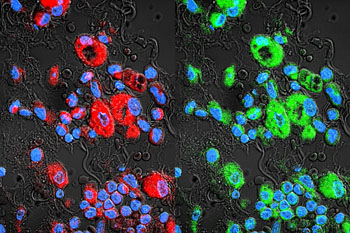Exosome Delivery Dramatically Boosts Anticancer Drug Potency
By LabMedica International staff writers
Posted on 25 Jan 2016
The use of exosome nanoparticles to transport the anticancer drug paclitaxel was shown to dramatically reduce the amount of drug required to kill lung cancer cells in culture and in a mouse model.Posted on 25 Jan 2016
Exosomes are cell-derived vesicles that are present in many and perhaps all biological fluids, including blood, urine, and cultured medium of cell cultures. The reported diameter of exosomes is between 30 and 100 nanometers, which is larger than low-density lipoproteins but much smaller than red blood cells. Exosomes, which contain RNA, proteins, lipids and metabolites that are reflective of the cell type of origin, are either released from the cell when multivesicular bodies fuse with the plasma membrane, or they are released directly from the plasma membrane. Exosomes have specialized functions and play a key role in coagulation, intercellular signaling, and waste management. Consequently, there is a growing interest in the clinical applications of exosomes for prognosis, therapy, and as biomarkers for health and disease.

Image: Drug-resistant lung cancer cells are in red. Paclitaxel-loaded exosomes (green) swarm the cancer cells and bypass their drug resistance (Photo courtesy of the University of North Carolina).
Investigators at the University of North Carolina (Chapel Hill, USA) developed and compared different methods of loading exosomes released by macrophages with paclitaxel (PTX), and characterized their size, stability, drug release, and in vitro antitumor efficacy. Reformation of the exosomal membrane upon sonication resulted in high loading efficiency and sustained drug release.
The investigators reported in the November 15, 2015, online edition of the journal Nanomedicine: Nanotechnology, Biology and Medicine that incorporation of PTX into exosomes increased cytotoxicity more than 50 times in drug resistant MDCKMDR1 (Pgp+) cells. They also found a nearly complete co-localization of airway-delivered exosomes with cancer cells in a mouse model of Lewis lung carcinoma pulmonary metastases and demonstrated a potent anticancer effect in this mouse model.
"That means we can use 50 times less of the drug and still get the same results," said senior author Dr. Elena Batrakova, associate professor of pharmacy at the University of North Carolina. "That matters because we may eventually be able to treat patients with smaller and more accurate doses of powerful chemotherapy drugs resulting in more effective treatment with fewer and milder side effects."
"Exosomes are engineered by nature to be the perfect delivery vehicles," said Dr. Batrakova. "By using exosomes from white blood cells, we wrap the medicine in an invisibility cloak that hides it from the immune system. We do not know exactly how they do it, but the exosomes swarm the cancer cells, completely bypassing any drug resistance they may have and delivering their payload."
Related Links:
University of North Carolina














